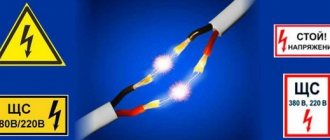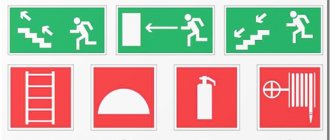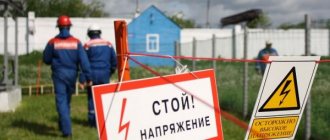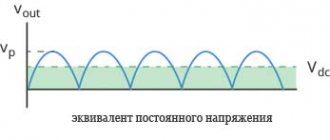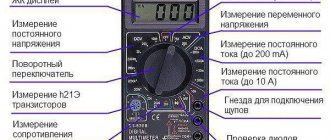- Technological connection
Electrical safety signs and posters
The use of safety signs and posters in electrical installations is associated with the need to ensure that operations with switching devices are prohibited (turning them on or off) so that during the operation of electrical equipment no one accidentally applies voltage to it.
Posters and signs warn of the dangers associated with approaching energized equipment. Safety posters may also identify the workplace.
According to their purpose, safety posters and signs are divided into:
- - prohibiting;
- — warning;
- - prescriptive;
- - pointing.
Depending on the nature of their application, electrical safety posters and signs are portable and stationary (permanent).
Warning
Warning signs and posters are used to inform a person about approaching an area that is energized. This type of safety signs includes:
- “Don’t get in! He will kill." Warns a person that when lifting, it is possible to approach elements that are under dangerous voltage.
- "Trial! Danger to life." Such a poster must be hung at the workplace when testing high-voltage equipment. The installation location is the fencing of this very workplace. The caption warns that there is a possibility of electric shock.
- “Stop! Voltage". Surely each of you has seen this poster on electrical installations and understands what it warns about.
- "Carefully! Electrical voltage." The safety sign is made in the form of a triangle with equal sides. It is used for installation on the doors of substations, power plants and electrical installations, as shown in the photo below.
Which of the following posters are prohibitive?
| Do not turn on! People are working. | Correct answer |
| Stop! Voltage. | Incorrect answer |
| Don't get in! Will kill. | Incorrect answer |
| Carefully! Electrical voltage. | Incorrect answer |
Ticket number 10
Question No. 1
How are premises classified in relation to the risk of electric shock to people?
| Premises without increased danger, premises with increased danger, dangerous premises, especially dangerous premises | Incorrect answer |
| Premises without increased danger, premises with increased danger, dangerous premises | Incorrect answer |
| Premises without increased danger, premises with increased danger, especially dangerous premises and the territory of open electrical installations | Correct answer |
| Non-hazardous premises, high-risk premises, dangerous premises, especially dangerous premises | Incorrect answer |
Question No. 2
Who should ensure the reliability and safety of electrical installations?
| Energy supply organization | Incorrect answer |
| Consumers | Correct answer |
| Rostechnadzor bodies | Incorrect answer |
| Service organization | Incorrect answer |
Question #3
How often is electrical safety knowledge testing carried out for electrical personnel?
| At least once a year | Correct answer |
| At least once every six months | Incorrect answer |
| At least once every three years | Incorrect answer |
| At least once every five years | Incorrect answer |
Question #4
How are the results of testing personnel knowledge on electrical safety documented?
| The test results are recorded in a journal of the established form, and personnel who successfully pass the knowledge test are issued a certificate of the established form. | Correct answer |
| The results of the inspection are recorded in a journal of the established form. | Incorrect answer |
| The test results are documented in a protocol in the established form, and personnel who successfully pass the knowledge test are issued a certificate in the established form. | Incorrect answer |
| The test results are recorded in the work book and in a certificate of the established form, which is issued to personnel who successfully pass the knowledge test | Incorrect answer |
Question #5
Who has the right to service electrical installations with voltages up to 1000 V?
| Workers from among the operational or maintenance personnel of the organization who have an electrical safety group of at least III | Correct answer |
| Workers from among the organization's repair personnel with an electrical safety group of at least III | Incorrect answer |
| Workers from among the operational or maintenance personnel of the organization who have an electrical safety group of at least II | Incorrect answer |
| Workers from among the operational or maintenance personnel of the organization with electrical safety group II or III | Incorrect answer |
Question #6
Who should install and replace current and voltage instrument transformers?
| Energy supply organization | Incorrect answer |
| Consumer personnel in agreement with the energy supply organization | Correct answer |
| Energy supervision authorities | Incorrect answer |
| Standardization and metrology bodies located at the place of registration of the owner of electrical energy metering devices | Wrong answer |
Question No. 7
What is meant by touch voltage?
| Voltage between two conductive parts or between a conductive part and ground when simultaneously touched by a person or animal | Correct answer |
| Voltage between two points on the ground due to the spreading of a fault current to the ground when they are simultaneously touched by a person’s feet | Incorrect answer |
| The voltage produced when current flows through a conductor between two points | Incorrect answer |
| Voltage between two points on the surface of the earth at a distance of 1 m from one another, which is taken to be equal to the length of a person’s step | Incorrect answer |
| Voltage between two points in an electrical circuit with different potentials | Incorrect answer |
Question #8
In what case should the grounding element be replaced?
| If more than 90% of its cross-section is destroyed | Incorrect answer |
| If more than 80% of its cross-section is destroyed | Incorrect answer |
| If more than 70% of its cross-section is destroyed | Incorrect answer |
| If more than 60% of its cross-section is destroyed | Incorrect answer |
| If more than 50% of its cross-section is destroyed | Correct answer |
Question No. 9
In which electrical installations do you need to wear dielectric gloves when using a voltage indicator?
| In electrical installations with voltages above 380 V | Incorrect answer |
| In electrical installations with voltages up to 1000 V | Incorrect answer |
| In electrical installations with voltages above 1000 V | Correct answer |
| In electrical installations with voltages above 10 kV | Incorrect answer |
Question #10
In which electrical installations are voltage indicators used to check phase coincidence?
| In electrical installations with voltages up to 1000 V | Incorrect answer |
| In electrical installations with voltage from 1 kV to 32 kV | Incorrect answer |
| In electrical installations with voltage from 6 to 110 kV | Correct answer |
| In electrical installations with voltage from 10 to 220 kV | Incorrect answer |
Ticket No. 11
Question No. 1
Which electrical installations are subject to the requirements of the Electrical Installation Rules?
| Only for AC electrical installations with voltage up to 380 kV | Incorrect answer |
| For newly constructed and reconstructed electrical installations of direct and alternating current with voltage up to 750 kV, including special electrical installations | Correct answer |
| For electrical installations under construction for direct and alternating current voltages up to 750 kV | Incorrect answer |
| For all electrical installations | Incorrect answer |
Question No. 2
Which premises are classified as high-risk premises?
| Rooms characterized by the presence of dampness or conductive dust | Incorrect answer |
| Premises characterized by the presence of metal, earthen, reinforced concrete and other conductive floors | Incorrect answer |
| Rooms characterized by high temperatures | Incorrect answer |
| Premises characterized by the possibility of simultaneous human contact with metal structures of buildings connected to the ground, technological devices, mechanisms, etc., on the one hand, and metal casings of electrical equipment (exposed conductive parts) on the other | Incorrect answer |
| Any of the listed premises refers to premises with increased danger | Correct answer |
Question #3
Who are the operational maintenance personnel?
| Personnel performing operational management and maintenance of electrical installations (inspection, operational switching, preparation of the workplace, admission and supervision of workers, performance of work in the order of routine operation) | Incorrect answer |
| Repair personnel specially trained and prepared for operational maintenance of the electrical installations assigned to them within the approved scope | Correct answer |
| Personnel providing maintenance and repair, installation, adjustment and testing of electrical equipment | Incorrect answer |
| Personnel entrusted with the responsibility for organizing technical and operational maintenance, carrying out repair, installation and commissioning work in electrical installations | Incorrect answer |
Question #4
What initial electrical safety group should an employee have when transferring from servicing electrical installations with voltages up to 1000 V to servicing electrical installations with voltages above 1000 V?
| No higher than second | Incorrect answer |
| No higher than third | Correct answer |
| No higher than fourth | Incorrect answer |
| Any group | Incorrect answer |
Question #5
What document is used for testing electrical equipment using a mobile testing unit?
| By order | Incorrect answer |
| Alongside | Correct answer |
| By order | Incorrect answer |
| According to the work plan | Incorrect answer |
Question #6
Previous6Next
Types of signs according to GOST
There are regulations that regulate the types of information signs used to prohibit or restrict activities on equipment. In accordance with this classification, safety posters and signs come in several types:
- Prohibition signs are products that inform about the prohibition of turning on or off the switching device in the panel during maintenance or repair work;
- Warning posters. In this case, the signs perform the function of informing personnel about approaching dangerous power lines and other high-voltage elements;
- Prescriptive signs are signs that are needed to determine the location of repairs or installation of equipment; they are most often placed by the senior foreman when planning line maintenance;
- Directional poster. This tool refers to information plates that are for reference purposes and indicate the characteristics of the line, grounding or voltage type.
These are the main groups of signs and posters that can most often be found when installing, connecting or repairing electrical installations. You can also classify such products based on their location. First of all, they are of the stationary type - these are those parts that are installed on stationary objects for the entire service life of the units. Most often these are warning and prohibition signs with information about high voltage, the direction of the main line and the schedule for maintenance work.
You can also separately highlight mobile signs. Unlike stationary ones, these parts are mounted on objects temporarily and after repairs or other actions are completed they can be removed and reused.
Prohibition posters
Electrical safety posters of this type have regulated sizes and colors. Most often these are red symbols and numbers on a white background in a red frame. These signs include:
- “Do not turn on again while energized” - this sign prohibits turning on the equipment without the consent of the employee responsible for performing the actions after it has been turned off. Most often, these parts are mobile and mounted on control units during maintenance or installation of new equipment. Dimensions – 100 by 200 millimeters, frame width – 5 mm. The letters and frame are made in red on a white background;
- "Do not turn on! People are working." Here the poster is temporary and prohibits turning on electricity to the main line. It must be installed on switches, buttons and control levers of automatic switches, during the operation of which voltage can be supplied to the conductors. Used for power plants up to 1000 V and higher. The color design in this product is in the form of white letters on a red background, dimensions can be 200 by 100 mm or 100 by 50;
- "Do not open! People are working." A prohibitory poster that must be hung on gate valves and valves, as well as ball valves that shut off the air supply to pneumatic switching devices (switches, disconnectors).
Important! Untimely start-up of such units can lead to the switching on of the device on which people are working, which will lead to an emergency situation. The design and dimensions of the plate are the same as in the first sign of this list.
Note! Prohibition signs used to maintain safety in electrical installations are categorical in nature, therefore their compliance is mandatory for all workers and services.
Warning posters
They are for informational purposes only and call for caution in any area or near electrical equipment. This type of plates includes:
- “Stop! Voltage" is a warning poster that belongs to a group of portable signs that informs about proximity to power lines with voltages of up to 1000 Volts. Most often it can be found near high-voltage lines laid externally by fastening them to reinforced concrete or metal supports. The size of the poster is 300 by 150 mm, it is made in the form of a red frame on a white background and black letters;
- “Don’t interfere, it will kill you” is one of the most common signs, installed on almost all transformers and automatic power-off units. Providing information in such a harsh form is fully justified, since the consequences of interfering with the operation of such equipment can harm human health. This type of poster can also be used on power line poles as directional signs signaling the repairman about the rated current on the conductors. The size of such a plate is 300 by 150 mm, black letters on a white background with a red frame 15 mm wide. It is allowed to place a zigzag arrow on the sign indicating a lightning strike;
- "The test is life-threatening." This is an information poster that warns of the danger of electric shock when conducting tests on a high-voltage main line. Such signs are used on workplace fences during work on high-voltage lines and equipment. The dimensions of this sign and the design style are the same as in the previous case;
- “Dangerous electric field, passage is prohibited without protective equipment.” A poster that provides information about the possible impact of electric fields on installers or maintenance personnel, and also prohibits the passage of people without wearing a special suit with a rubber dielectric coating. Installed on power units in which the voltage exceeds 330 kV at a height of 150-200 cm on the fences of areas where the electric current intensity is higher than 15 kV/m. In such places, the electromagnetic field is below normal, and therefore can have a detrimental effect on the human body;
- "Caution, electrical voltage." This poster differs from other warning signs in its shape, which looks like an isosceles triangle with a zigzag lightning bolt inside. This type of plate must be used on all power installations and on some electrical equipment that operates on direct or alternating current above 220 Volts.
Prohibiting
The very name of such posters determines their main goal - this is to impose a ban on any manipulations with switching devices (switches, circuit breakers, etc.), so that when carrying out electrical work, someone does not accidentally supply electricity to the power supply network of an electrical installation. Let's look at each of the prohibition signs in order.
- The sign indicates an area where there is a strong electric field that is dangerous to life. Passage through such an area without special protective equipment is strictly prohibited. A sign is installed on open switchgears (OSD) with a voltage of more than 330 kV and an electric field strength of more than 15 kV/meter. Placement of the poster: fencing the area at a height of at least 1.8 meters.
- The poster is hung on switching devices such as switches, buttons, keys and so on. The sign prohibits the supply of voltage until maintenance or repair work is completed. If there are no switching elements, the poster is installed near the removed fuses. Used to ensure electrical safety in electrical installations with voltages up to 1 kV and higher.
- The functions and installation locations of this poster are no different from the previous safety sign. Area of use: underground cable and open overhead lines for supplying electrical energy, on which preventive or repair work is carried out. The poster prohibits any manipulation of switching devices until the work is completed and the poster is removed.
- This prohibitory poster is hung on keys that are designed to control switches on high-voltage lines (VL). Functionally, the sign establishes a ban on erroneously manually turning on the power of a high-voltage power line while maintenance or repair work is being carried out on it, which could lead to electric shock to people.
The entire above list of electrical safety signs is prohibitive, as it prohibits certain actions. Posters can be either portable or stationary, installed on a permanent basis.
Types of posters by purpose
These funds are classified depending on their functional purpose into the following types:
- Prohibiting action , this group imposes a ban on the use of switching equipment to prevent its activation during repair and maintenance work in the area of responsibility.
- Preventive action is prescribed to be installed in places where there is a danger of accidental contact with live parts of an electrical installation, or a danger of approaching them. In addition, this category includes a means that informs about the prohibition of entering the electric field zone without appropriate protective equipment.
- Prescriptive in nature . The purpose of these means is to point maintenance or repair personnel to a specially prepared place that meets safety standards.
- Indicating destination . Currently, GOST provides only one means for this group, informing about the imposition of portable grounding.
Let's look at what products are included in this or that group, the conditions for their use, the accepted format, as well as the acceptable colors. The sequence will be the same as adopted in GOST 12.4.026 2015 (Appendix 9).
Prohibiting
This category includes four types:
- Prohibiting the switching on of switching devices that provide power to electrical installations.
People are working” The design is made in two formats: 100.0 x 50.0 mm and 200.0 x 100.0 mm. The inscription is made in red letters on a white background. The inscription is framed with a frame of the same color as the letters. The edging has a width of 1.25 mm and is made in white.
Electrical safety rules allow the use of these safety equipment regardless of the voltage class of electrical devices. Installation is prescribed in places where switching devices are controlled, providing power supply shutdown. If the circuit diagram of the electrical device does not imply the presence of such switches, the poster is installed on the removed fuses.
- Prohibition on turning on power lines.
Work on the line! The dimensions remain standard (200.0x100.0 and 50.0x100.0). As for the inscription, it is executed inversely to the previous version, that is, in white letters. Accordingly, the colors of the edging and frame change, but their sizes remain the same.
The purpose is the same as the previous poster, adjusted for cable and overhead lines.
- Prohibition on supplying working fluid to the pipeline, opening cylinders, etc.
People are working." The form factor and color design correspond to the above electrical safety device from paragraph 1. This electrical protective device is installed on shut-off valves in the following cases:
- When it is necessary to prohibit the use of shut-off valves for pneumatic drives of switching devices. An example of such devices is high-voltage switches.
- If it is necessary to prevent the supply of working fluid into pipelines in order to prevent an emergency and ensure the safety of the repair team.
- Prohibition on reactivating the power line switching mode after it has been turned off. This issue must be previously agreed upon with the person responsible for safety.
Safety sign materials
All signs and plates that are presented on our website are made (at least) in 3 ways on different materials with a choice of sizes:
| Signs on self-adhesive film are very convenient to use, because They can be easily glued to any smooth surface by first removing the siliconized backing. The advantages of this material are obvious - a wide range of operating temperatures (from −40°C to +80°C), service life on outdoor objects - at least 3 years, reliable polyacrylate adhesive that ensures constant adhesion |
SELF-ADHESIVE FILMLearn more
| Signs on plastic are distinguished by their reliability and relatively inexpensive cost. Such a sign can be attached to any (preferably flat) surface: to a wall or fence - with screws or nails, to a grille - using clamps or wire, to a smooth surface (for example, on a door) - with double-sided tape. According to the standard, we use PVC plastic 2 mm thick (European or Russian production), however, you can order a sign on plastic of any thickness from 0.5 mm to 100 mm |
PLASTIC PVC Find out more
| Such signs are made on the basis of galvanized metal or metal with a polymer coating (depending on the manufacturing method) with a thickness of 0.7-0.8 mm. Galvanized sheet is a sheet that has undergone a special anti-corrosion galvanizing treatment. As a result of this treatment, the sheet acquires the properties of stainless steel. Despite the fact that the thickness of the ferro-zinc layer on the surface of the sheet is only a few micrometers, the sheet is able to resist the harmful effects of the environment for an almost unlimited period of time |
METALknow more
| Reflective signs are used both in dark rooms and outdoors at night. The surface of a reflective sign works like a mirror - the light of headlights or a flashlight is reflected from the surface of such a sign, greatly improving its readability. The basis of such a sign can be self-adhesive PVC film, PVC plastic 2 or 4 mm, as well as metal |
REFLECTIVE MATERIALS Find out more
| Photoluminescent signs are expensive and are only needed to indicate escape routes in case of fire or other emergency situations in which the sign must be visible in complete darkness. For more detailed information about the options for manufacturing photoluminescent signs (materials and sizes) of signs, read our special article “Review of Photoluminescent Signs” |
PHOTOLUMINESCENT MATERIALS Find out more
Posters as means of protection
Brightly colored images with explanatory inscriptions or symbols are called posters or safety signs. They have a certain geometric shape: rectangular, triangular, square.
Posters are needed to warn both workers and bystanders about the potential hazards posed by electrical installation equipment. Some posters directly prohibit performing certain actions, others carry an informational load, others allow and order work.
The document applies to any means of protection used by organizations of various forms of ownership - both state enterprises and private property, especially if the voltage in electrical installations is above 1000 V.
Workers involved in work in electrical installations must be provided with protective equipment, including posters, and explained how and where they should be used in order to ensure the safest possible working conditions. Portable signs must be part of the inventory that field teams are armed with.
Posters and signs are made in accordance with GOST. Unlike tools and clothing, they do not require markings and do not need to be numbered or otherwise marked.
Directional posters
A typical representative of this group is the “GROUNDED” sign. It indicates the grounding of a certain section of the electrical installation and the prohibition of the supply of electric current to it.
Its location is usually the drive of the switching equipment. If prohibition and directional posters are used at the same time, the latter should be hung from above. Dimensions according to GOST 100x200 or 50x100 mm, with a corresponding white border width of 13 and 5 mm. The inscription uses white letters located on a blue background.
Electrical Safety Posters
Today I am publishing posters on electrical safety
, which I found in my bins. Copyright: SOWELO Publishing House.
What are posters for? Unlike books, posters present the information presented in books clearly and intelligibly, but at the same time briefly and interestingly. Posters can be used to refresh your memory of necessary information, for training staff, and simply to create a working environment.
However, one should not think that safety posters can completely replace books. For example, for an electrician this is PUE (Electrical Installation Rules). This book, as well as many others, can be freely downloaded on the SamElectric.ru blog from the page.
There are a lot of posters (more than 100), about half of them are in this article, all of them can be downloaded at the end of this article. The rest of the safety posters that are not included in this part are in.
I am posting several posters for display. Naturally, first of all - those that correspond to the topic of my blog - Electrical Safety
For those who are interested in the topic in more depth, or are planning to take the electrical safety exam (for the admission group), I also advise you to visit the pages and (part 2). There you can freely download the books necessary to prepare for the exam.
Well, I’ll comment a little on the posters that will be on display.
Electrical safety posters and signs
Posters and electrical safety signs (manufactured in Belgorod) are produced on self-adhesive film and plastic in accordance with GOST R 12.4.026-2001 “Instructions for the use and testing of protective equipment used in electrical installations” and SO 153-34.03.603-2003 “Instructions for application and testing of protective equipment used in electrical installations" (Appendix 9). It is possible to produce signs and posters according to customer sketches.
By nature of application
This classification for electrical safety posters and signs allows you to determine whether the device will be installed on a permanent basis or whether it is portable. The first, for the most part, include signs, for example, voltage indicators, which are a triangular information plate with a stylized image of lightning.
Stationary
Of the types listed above, these include the signs given in paragraphs 5 and 6, as well as the warning poster from paragraph 10
Portable
All other posters that were discussed are portable, that is, those that are installed in new places.
It makes sense to create sets of portable posters only when standard maintenance or repair of electrical network components or equipment powered by it is performed. In such cases, you can take a certain number of mandatory, prohibitive or other safety posters and signs, including “danger to life” signs, in advance.
The need to warn workers
Safety posters in electrical installations are needed to ensure the safety of personnel working at the enterprise. They provide early warning to people of electrical hazards to prevent injury and death in the workplace. Saving human life is always a priority task for any production manager, especially if we are talking about electrical installations.
Posters and safety signs in electrical installations are used to prohibit or permit the performance of certain actions when the voltage is on, to notify employees about connected devices, about the distance at which they can approach the switch, to indicate the direction and location of structures and units.
Methods for making signs on film:
1. Full-color printing Used for small circulations (from 1 to 100 pieces) of medium-sized signs, small (from 1 to 50 cm2) stickers (circulations from 1 to 1'000 pieces) and large signs with circulations of one sticker. This method is direct large-format full-color photo printing with eco-solvent inks made in Europe on advanced Japanese Mimaki equipment, which allows you to obtain a high-quality full-color image
2. Silk-screen printing It is used in the production of medium circulations of signs: small (in size) - from 1'000 to 100'000 and medium - from 100 to 10'000 pieces. Silk-screen printing or screen printing is the process of applying an image to film by transferring it from a stencil (silk canvas with an image of a sign) in a semi-automatic mode. The size of the signs is also limited in size - no more than A1 format and colors - no more than 4, which is perfect for making almost all signs on film. When producing signs and plates using silk-screen printing, we use imported UV-curing (high-quality and odorless) paint made in Germany or Japan on a Russian-assembled semi-automatic screen printing machine
3. Offset printing Used for very large circulations of stickers (from 10,000) with a limitation on the size of the sticker (no more than A4 format). This method involves printing by imprinting a sign on film, but due to the complexity of preparing the circulation, it is used extremely rarely. When producing signs, ORACAL 640 film or its analogue with similar characteristics is used
CHARACTERISTICS OF PVC FILM:
What are safety helmets used for?
Helmets are designed to protect the worker’s head from mechanical damage, from water and aggressive liquids, as well as from electric shock when accidentally touching live parts energized up to 1000 V.
Which of the following posters are prohibitive?
Do not turn on! People are working.
Which of the following posters are warning signs?
Carefully! Electrical voltage
Which of the following posters are classified as signposts?
Grounded.
What type of safety poster is a poster with the inscription “Caution! Electrical voltage?
To the warnings
What type of safety poster is a poster that says “Grounded”?
To the index fingers
In which electrical installations are voltage indicators used to check phase coincidence?
In electrical installations with voltage from 6 to 110 kV
What are the requirements for the appearance of dielectric carpets?
They must have a corrugated front surface, one color
What background should the warning sign “Caution! Electrical voltage”, which is mounted on the outer door of the transformers?
Yellow
What background should the warning sign “Caution! Electric voltage”, which is applied using a stencil to a reinforced concrete overhead line support?
The background is the color of the concrete surface
Rules for the use and testing of protective equipment used in electrical installations
What specific effect does electric current have on the human body?
is expressed as follows: electric current, passing through a living organism, produces a thermal (thermal) effect, which is expressed in burns of individual parts of the body, heating of blood vessels, blood, nerve fibers, etc.; electrolytic (biochemical) effect - expressed in the decomposition of blood and other organic liquids, causing significant disturbances in their physical and chemical compositions; biological (mechanical) effect - expressed in irritation and stimulation of living tissues of the body, accompanied by involuntary convulsive contraction of muscles (including the heart, lungs).
Which electric current is more dangerous for humans: direct or alternating?
Alternating current
What are the main “current loops”—pathways for electric current to pass through the human body?
Arm-arm, arm-leg, arm-head, leg-leg, head-leg
Groups of basic characters
In addition to the rules for placing such images, the legislation also divides such signs into various groups depending on their intended purpose as well as the hazard factors of production operations.
Note! Since work activities are of a different nature, such types should either indicate risks or regulate the actions of personnel in the event of an abnormal or emergency situation.
Prohibitory signs
Prohibitory signs respectively indicate the presence of danger during work or a harmful production factor, as well as a prohibition on the implementation of certain actions by personnel. Such illustrations indicate prohibitions on workers, for example, from smoking indoors and turning on household or other electrical appliances. Otherwise, if the requirements of plates or industrial controls are violated, abnormal or dangerous situations are likely to occur. This icon can also be of a warning nature.
Prohibitions must be placed in a visible place, and their meaning is communicated to workers during briefings, signed in a special magazine.
Special evacuation and prescriptive images
Demonstrative elements
Indicative illustrations serve to indicate the presence of certain factors or the use of production equipment in accordance with operating procedures. Such elements serve to better inform citizens about the conditions and features of the activities of certain workshops, divisions, departments or other staff units of the company. Also such a symbol. The inscription or sticker must indicate an explanation of the various types of work activities.
Evacuation
Evacuation symbols are of a specific nature and indicate safe exit routes in the premises. In the event of a danger, emergency or emergency, such signs should help workers find a safe way to exit. The responsibility for producing such information signs lies with the occupational safety specialist in accordance with the specific location of such exits and premises in the building.
Safety signs when working in an office
Medical purpose
If there are medical units or regular first aid kits in special cabinets at the enterprise, there must be special symbols indicating their location.
Important! Such pictures should be bright and placed in a visible place
Mandatory signs
Mandatory or warning safety signs must indicate the presence of certain occupational factors that may create a hazard. Such images usually have a triangular appearance and indicate the presence of specific activities in a regular premises or any department. The placement of such images is also mandatory and should occur not only at the entrance to the premises, but also directly near industrial installations.
Combined and group
Combined illustrations are of a mixed nature and may indicate both the presence of a hazard and different instructions. They also symbolize instructions for taking action in the event of an emergency or emergency. Such designations are made taking into account the specifics of the organization of work in the company and are placed in special staff departments that may use hazardous or harmful substances in their work.
The labor protection store offers you two types of photoluminescent fire safety signs:
Type 1: Such photoluminescent safety signs are installed in the premises of institutions, organizations, and enterprises with less than 100 people at a time. Type 1 photoluminescent signs are made on the basis of Oracal self-adhesive film by applying a photoluminescent layer with special light-accumulating paints. Such signs are inexpensive, but have the disadvantage of a short afterglow (15-20 minutes after the light goes out)
Type 2. Full compliance with GOST: Such photoluminescent safety signs are installed in the premises of institutions, organizations, enterprises with more than 100 people at a time; in the premises of institutions, organizations, enterprises with permanent residence of people; in rooms with the presence of harmful substances; explosion and fire hazardous areas, mines, subways, etc. Photoluminescent signs in full compliance with GOST 12.2.143-2009 and GOST 12.4.026-2015 are manufactured on certified light-accumulating film. The certificate and test results of photoluminescent film can be found here
Additionally: Photoluminescent materials can be applied both to plastic (plastic photoluminescent signs) and to metal sheets (metal photoluminescent signs)



